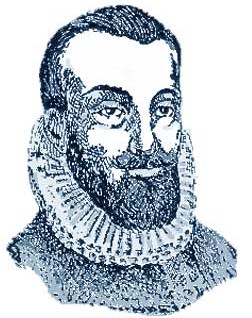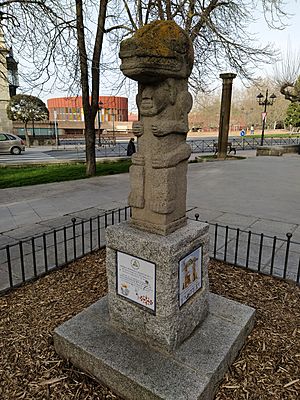Gil González Dávila facts for kids
Gil González Dávila was a Spanish explorer and leader. He was born around 1480 and died on April 21, 1526. He is known for being the first European to explore the country we now call Nicaragua.
Contents
Early Adventures
Gil González Dávila first appeared in official records in 1508. He was given a special job by the king to check financial records and taxes. He likely traveled to Santo Domingo (in today's Dominican Republic) for this work. In 1511, he was named the main accountant for the Spanish lands in the Americas, known as Hispaniola.
By 1514, Gil González was an important part of the treasury team in Hispaniola. He even became a teacher and had a large estate where many native people worked. In 1518, he sent a report to King Charles V. This report was very critical of how the Spanish colonies were being managed.
While in Spain, Gil González met Andrés Niño. Niño was a skilled sailor who wanted to explore the Pacific Coast. With help from a powerful bishop, Gil González and Niño got permission from King Charles to start an expedition. Gil González would be the captain, Niño the main pilot, and Andrés de Cereceda would handle the money.
Exploring Costa Rica and Nicaragua
In June 1519, King Charles approved their journey. Gil González and Niño quickly sailed to the Americas, arriving in Panama in January 1520. Gil González showed his royal orders to the governor of Panama, Pedrarias Dávila. These orders allowed him to check tax records and prepare for exploring the Pacific coast of Central America.
Governor Pedrarias was not happy about this. He didn't want his tax records checked and felt Gil González was entering his territory. So, he made it hard for Gil González to get ships, supplies, and men. Because of this, Gil González and Niño had to build four small ships themselves in the Pearl Islands.
On January 26, 1522, the expedition finally set sail. But their ships leaked, forcing them to land in western Panama. Gil González led his men by land towards what is now Costa Rica. Niño sailed along the coast, keeping the ships in sight of the land party.
Their records show they met many native people. They also collected a lot of gold and pearls. They reached a nice bay they named San Vicente (now Caldera) in Costa Rica. They continued north to the lands of Nicoya, where they found many native communities. The Nicoyans did not fight, and more gold and pearls were collected.
Gil González kept going north. He discovered and claimed the bay of Corinto and then the Golfo de Fonseca. He named the gulf after their patron, Bishop Juan Rodriguez de Fonseca.
He explored the rich western valleys and was impressed by the native cultures there. He discovered two large lakes, later named Lake Nicaragua and Lake Managua. His small group collected gold and met many native people. Eventually, they made too many demands on the native people, who then attacked them. Gil González managed to lead his men back to their ships and sail south.
In June 1523, Gil González returned to Panama. He had three leaky ships, 100 tired men, but also a lot of gold. He shared his discoveries of "Nicaragua," its people, cities, and wealth. He named the area after a native leader, "Nic-atl-nauac," which became "Nicarao" in Spanish.
Adventures in Honduras
Governor Pedrarias wanted control of the rich lands in Nicaragua. He tried to arrest Gil González and take his gold. But Gil González escaped to his base in Santo Domingo. There, he used his new wealth to prepare another trip back to Nicaragua.
In early 1524, Gil González sailed for Nicaragua again. A storm pushed his ship to a bay on the Caribbean coast of Honduras. He had to throw horses overboard to lighten the ship, which is why the place was named Puerto Caballos (Horse Port, now Puerto Cortés).
He then sailed further west and founded a town called San Gil de Buenavista. After leaving some settlers there, he sailed east along the coast of Honduras. He planned to march into Nicaragua from there. Meanwhile, the settlers at San Gil de Buenavista moved to a safer spot called Nito.
In the summer of 1524, Gil González led a strong group south towards western Nicaragua. Along the way, he met a Spanish group and learned that his territory had been entered by an army from Panama. This army was led by Francisco Hernández de Córdoba.
Córdoba sent a small force led by Hernando de Soto to deal with Gil González. Soto's group was surprised by an attack, but they defended themselves. The two leaders agreed to a truce. However, Gil González tricked Soto. With more men, he attacked again and captured Soto's force. But Gil González then released the prisoners. He might have feared Córdoba's much larger army. He returned to Puerto Caballos.
In May 1524, another Spanish leader, Cristóbal de Olid, arrived in Honduras. He had orders from Hernán Cortés to start a colony. Olid founded a colony and then declared himself governor, going against both Cortés and Gil González. Later, Cortés sent Francisco de las Casas to fix the situation. But Olid captured both Las Casas and Gil González. Eventually, Olid's own men turned against him, freeing the prisoners. Olid was found guilty of treason and was executed.
Las Casas and Gil González decided to work together and declared their loyalty to Cortés. They both planned to return to Mexico. Las Casas left López de Aguirre in charge, telling him to found a town at Puerto Caballos. However, López de Aguirre found the area unsuitable and moved east, settling near modern Trujillo. Meanwhile, Cortés himself decided to travel to Honduras to make sure the colony was safe.
Later Life
When Las Casas and Gil González arrived in Mexico, they found Salazar de la Pedrada in charge. They refused to accept his authority, saying they were loyal only to Cortés. Salazar had them arrested and accused them of Olid's murder. He planned to execute them, but was eventually forced to send them as prisoners to Spain.
What happened to Gil González after he arrived in Spain is not fully known. His old supporter, Bishop de Fonseca, had died in 1524. His new supporter, Hernán Cortés, also had problems with the king. Gil González Dávila died in his hometown of Ávila on April 21, 1526. The only hint of his later life was that he had a son with the same name.
See also
 In Spanish: Gil González Dávila para niños
In Spanish: Gil González Dávila para niños
- El Nuevo Diario
- Leon Viejo, Nicaragua



